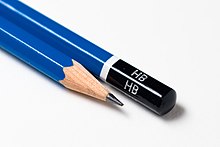Wikijunior:How Things Work/Pencil
Who Invented It?
[edit | edit source]The most primitive type of pencil is believed to be the stylus, which was a thin metal stick, often made from lead and used for scratching in a layer of wax contained in a wooden frame in Roman Usage or scratching on papyrus, a form of early paper. They were used extensively by the ancient Egyptians and Romans. The word pencil comes from the Latin word pencillus which means "little tail".
What is it made of?
[edit | edit source]
All pencils have these two parts:
- Barrel: The barrel is usually made of wood and occasionally made of clay, recycled paper, or recycled plastic. It is the largest, heaviest part of the pencil and provides a surface to hold.
- Lead: The "lead" is so named because when pencils were first invented, this part was made of elemental lead. Now this part is made of graphite, a form of elemental carbon where the carbon atoms are arranged in thin sheets. Friction between the graphite and paper-like surface causes tiny flakes of graphite to come off and become attached to the surface. To prevent smearing, the graphite is mixed with a small amount of clay to harden it and make it easier to work with.
Some pencils have an extra accessory:
- Eraser: The eraser allows the user of the pencil to manually and mechanically delete, by rubbing away, the unwanted marks from a surface. The eraser is attached to the barrel with a metal collar, called a ferrule. This device was first introduced by Hymen Lipman on March 30, 1858, receiving the first patent for attaching an eraser to the end of a pencil. Lipman sold his patent in 1862 to Joseph Reckendorfer for $100,000, who went to sue the pencil manufacturer Faber for infringement. In 1875 the Supreme Court of the United States ruled against Reckendorfer, declaring the patent invalid.

- Sharpener: A sharpener allows the user of the pencil to make their pencil sharper especially when it's blunt and scraping on the paper, this makes the pencil shorter. (pictured)
Types
[edit | edit source]Some types of pencils are:
- Graphite pencils: These are the most commonly found pencils. They are made up of a mixture of clay and graphite.
- Mechanical pencils: These pencils push the lead through a small opening using mechanical methods. They are popular because they do not need to be sharpened and the lead is replaceable.
- Pop-a-point pencils: This type of pencil is also known as non-sharpening pencils. In this type many sharp points are placed in the body of the pencil. When one point becomes blunt, it is removed and inserted at the top of the body. This causes the next sharp point to appear from the writing end of the body.
How is it used?
[edit | edit source]Pencils can be used for a variety of purposes, some productive, others not. The obvious use is to write letters to intimate friends, or teachers and principles. The graphite, however, usually makes the paper rather messy as it is folded, and this is not always the most exciting method of intimacy. Another use for a pencil is the popular game of slap, a game that middle school children reportedly still play today. The object of the game is to take turns slapping an opponents pencil with the tip of one's own pencil in succession. The first pencil to break loses.
Pencils sometimes fall into the role of a chew-toy, most humans when nervous or absent in their thoughts, will bite a pencil (or similar object, failing to have one the nails are also a common choice), in this way most people can easily identify and personalize their pencils, this can also be considered as imparting a type of protection to the object, since any other person would probably object using that pencil in the future (it is of importance to note that a complete destruction of the object as a result of this action is rarely seen, and due to the hardness of the wooden barrel, quite difficult).
Thus, the pencil was a good friend to many people when it came out. Sadly, as newer methods of writing have emerged, the pencil has been relegated to lesser status and uses. People now write messages on computer screens, never having to come close to a sharpener. One can only wonder what the keyboard will become when something newer comes along.
How Dangerous is it?
[edit | edit source]The graphite used in pencils was originally thought to be lead. The term lead is still used to refer to the core of pencils even though that isn't actually what it is.
The "lead" in pencils is actually graphite and it is not dangerous if accidentally ingested. But if it happens to puncture you or cut you, wash your wound with peroxide to kill the germs.